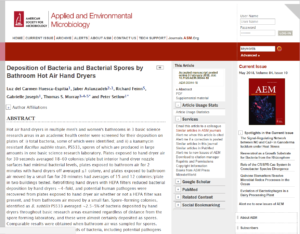Deposition of Bacteria and Bacterial Spores by Bathroom Hot Air Hand Dryers.
(AEM) — While there is evidence that bathroom hand dryers can disperse bacteria from hands or deposit bacteria on surfaces, including recently washed hands, there is less information on: i) the organisms dispersed by hand dryers; ii) if hand dryers provide a reservoir of bacteria or simply blow large amounts of bacterially contaminated air; and iii) if bacterial spores are deposited on surfaces by hand dryers. Consequently, this study has implications for the control of opportunistic bacterial pathogens and spores in public environments including healthcare settings. Within a large building, potentially pathogenic bacteria including bacterial spores may travel between rooms, and subsequent bacterial/spore deposition by hand dryers is a possible mechanism for spread of infectious bacteria including spores of potential pathogens if present.

Short summary of the journal paper
by
KEITH REDWAY
This study, conducted at the University of Connecticut, demonstrated that hand dryers in washrooms can deposit bacteria, including potential pathogens, on surfaces and the hands of users. It also showed that bacterial spores from one source can be dispersed to other rooms over large distances throughout a building.
The researchers sampled 36 washrooms on different floors in 3 buildings on the same site and found that when the hand dryers in them were switched off for 18 hours they isolated 6 bacterial colonies on average per exposed agar plate. However, when the hand dryers were switched on and agar plates exposed to the air from them for only 30 seconds, average bacterial counts increased to 18, 24 and 60 colonies per plate respectively in the 3 buildings, with a maximum colony count of 254.
The spores of a particular strain of Bacillus subtilis were detected at least 130 metres from their source (a research laboratory) and over 20 metres above it on different floors in the same building.
After sampling, the researchers considered it unlikely that the hand dryer nozzles harboured large numbers of bacteria and, therefore, the main source of the high bacterial counts must be the air drawn into the dryers and blown out over the hands of users and into the washroom environment.
The workers speculate that the reason hand dryers may disperse so many bacteria is the large amount of air that they emit. They cite one particular model of hand dryer which emits air at over 5,000 metres per minute at the nozzle.
Retrofitting of HEPA filters to the hand dryers reduced bacterial counts approximately 4-fold, but did not completely reduce them.
Since it is well recognized that the hands play a major role in the transmission of bacteria and other microorganisms in healthcare establishments, the food industry and other settings, this study has implications for the control of infection. It shows that potentially pathogenic bacteria, and particularly bacterial spores, may travel large distances and between rooms, and that their subsequent deposition by hand dryers is a possible mechanism for the spread of infection.
Although the spore-bearing bacterium detected in this study was non-pathogenic, the results of this study have implications for the transmission of pathogens such as Clostridium difficile, a major cause of healthcare-associated infections. Since this species is also spore bearing, the researchers suggest that its transmission will not be sufficiently reduced to safe levels by either hand washing or standard surface decontamination.
The authors recommend that other methods of hand drying, such as paper towels, be considered and add that all 36 washrooms at the University of Connecticut that were tested in their study now have paper towel dispensers installed.
Quote:
“This is yet another study highlighting that the method of hand drying should be carefully considered, especially in the control of infection in health-care settings. It complements the results of other studies that show that hand dryers and jet air dryers are likely to increase the risk of the transmission of not only bacteria but also fungi and viruses compared to other hand drying methods such as paper towels.”
Details of the Study
9 February 2018
Huesca-Espitia, L.C. et al. (2018).
Deposition of Bacteria and Bacterial Spores by Bathroom Hot Air Hand Dryers.
Appl. Environ. Microbiol. doi:10.1128/AEM.00044-18
link: http://aem.asm.org/content/early/2018/02/05/AEM.00044-18.abstract











